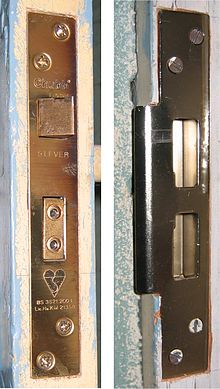- Mortise lock
-
A mortise lock (also mortice lock in British English) is one that requires a pocket—the mortise—to be cut into the door or piece of furniture into which the lock is to be fitted. In most parts of the world, mortise locks are generally found on older buildings constructed before the advent of bored cylindrical locks, but they have recently become more common in commercial and upmarket residential construction in the United States. They are widely used on all ages of domestic properties in the United Kingdom and Argentina.
The term “mortise” comes from the Latin root “mortuus” meaning to die because 17th century judges would sentence the harshest criminals to life in ‘mortuus obituatorium” prison cells, where the door was known to be secured by the most robust locks that were impossible for any attempts by the convicts’ friends to break him out.[citation needed]
The parts included in the typical mortise lock installation are the lock body (the part installed inside the mortise cut-out in the door); the lock trim (which may be selected from any number of designs of doorknobs, levers, handle sets and pulls); a strike plate, or a box keep, which lines the hole in the frame into which the bolt fits; and the keyed cylinder which operates the locking/unlocking function of the lock body. However, in the United Kingdom, and most other countries, mortise locks on dwellings do not use cylinders, but have lever mechanisms.
The installation of a mortise lock cannot generally be undertaken by the average homeowner since it is labor intensive and requires a working knowledge of basic woodworking tools and methods. Many installation specialists use a mortising jig which makes precise cutting of the pocket a simple operation, but the subsequent installation of the external trim can still prove problematic if the installer is inexperienced.
Although the installation of a mortise lock actually weakens the structure of the typical timber door, it is stronger and more versatile than a bored cylindrical lock, both in external trim, and functionality. Whereas the latter mechanism lacks the architecture required for ornate and solid-cast knobs and levers, the mortise lock can accommodate a heavier return spring and a more solid internal mechanism, making its use possible. Furthermore, a mortise lock typically accepts a wide range of other manufacturers' cylinders and accessories, allowing architectural conformity with lock hardware already on site.
Some of the most common manufacturers of mortise locks in the United States are Arrow, Baldwin, Best, Corbin Russwin, Emtek, Falcon, Schlage, and Sargent. Also, many European manufacturers whose products had been restricted to "designer" installations have recently gained wider acceptance and use.
Mortise Lock standards: There are several different standards for mortice locks in use, the most common is:
British Standard (small): Faceplate length: 152.5mm (6 inches) Backset:44.5mm (1¾ inches) C/C(lever lock): 57mm (2¼ inches). C/C(bathroom mortise lock): 57mm(2¼ inches). Used in internal doors.
British standard (large), BS3621: Faceplate length: 176mm (7 inches). Backset: 57mm (2¼ inches). C/C(lever lock): 57mm (2¼ inches). C/C(cylinder lock): 45mm (≈ 1¾ inches). Used in entrance doors.
American standard, ANSI A156.13, ML9000-series: Faceplate length: 203mm (8 inches). Backset: 70mm (2¾ inches) . Used in entrance doors.
Scandinavian standard (small), SS 817382, 20-series: Faceplate length: 150mm. Backset: 45mm. C/C(lever lock): 72mm. C/C(bathroom mortise lock): 72mm. C/C(cylinder lock): 68mm. Used in internal doors.
Scandinavian standard (large), SS 817383, Modular Lock: Faceplate length: 225mm. Backset: 50mm. C/C(cylinder lock): 103.5mm/105mm. C/C(lever lock): 104mm Used in entrance doors.
German standard, DIN 18 251: Faceplate length: 235mm. Backset: 55mm. C/C(lever lock): 72mm. C/C(cylinder lock): 72mm. C/C(bathroom mortise lock): 78mm. Used in entrance doors and internal doors.
Italian standard: Faceplate length: 240mm. Backset: 35mm/40mm/50mm/55mm. C/C(lever lock): 92mm. C/C(cylinder lock): 88mm C/C(bathroom mortise lock): 92mm. Used in entrance doors and internal doors.
Older standards: These standards are no longer in use in new doors, but replacement locks are still being made.
Norwegian standard (large): Faceplate length: 210mm. Backset: 60mm(lever lock)/55mm(cylinder lock). C/C(lever lock): 72mm. C/C(cylinder lock): 95.5mm. C/C(bathroom mortise lock): 72mm.
Norwegian standard (small), 22-series: Faceplate length: 157mm. Backset: 55mm. C/C(lever lock): 72mm. C/C(bathroom mortise lock): 72mm. C/C(cylinder lock): 68mm.
Swedish standard (small): Faceplate length: 215mm(earlier)/205mm(later). Backset: 45mm. C/C(lever lock): 72mm.
Danish standard: Faceplate length: 230mm. Backset: 57mm(lever lock)/60mm(cylinder lock). C/C(lever lock): 72mm. C/C(cylinder lock): 72mm.
Categories:- Locks
- Door furniture
Wikimedia Foundation. 2010.

